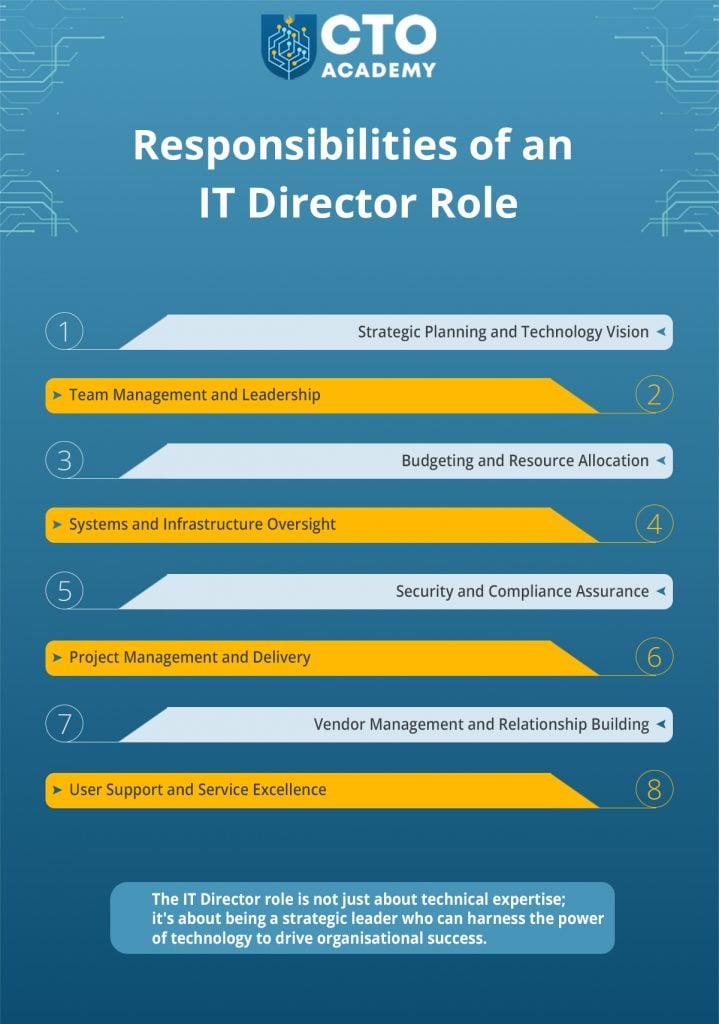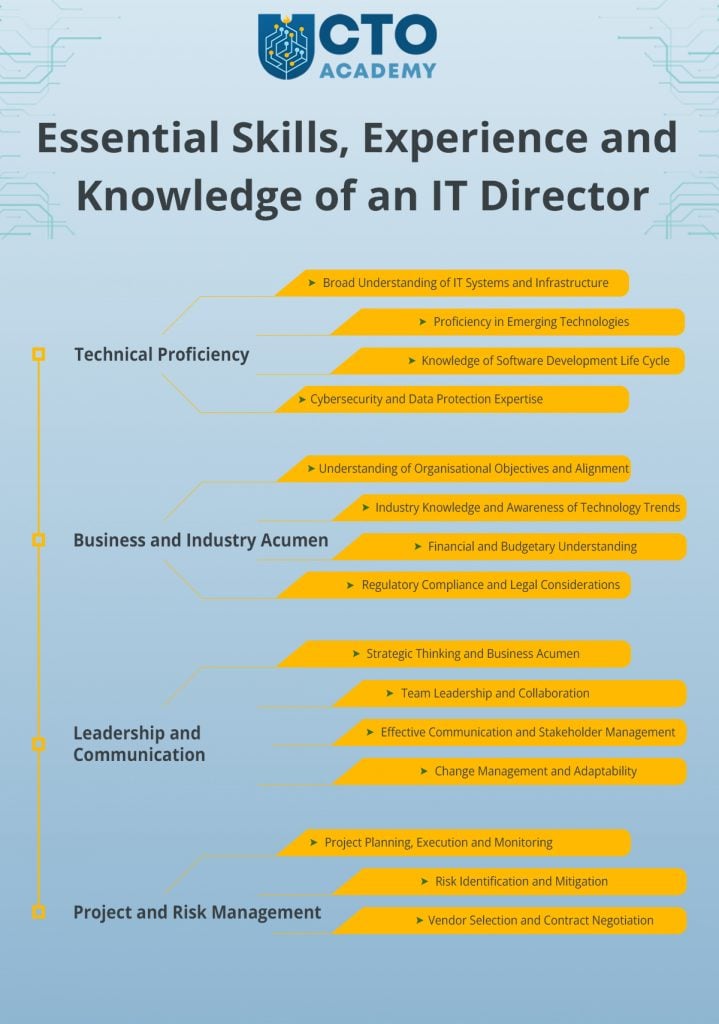An IT director is a senior-level executive overseeing the technology infrastructure, systems and operations. Sometimes called a director of technology, this type of tech leader plays a crucial role in ensuring that the organisation’s technology supports its strategic objectives and provides efficient solutions for the business.
Generally speaking, the job requires a balance between strategic thinking, technical expertise, leadership and effective communication. All of this is necessary to drive technology initiatives and support the organisation’s success.
This guide, therefore, provides aspiring technology leaders, such as software engineers, with valuable insights into the responsibilities, skills, experience and knowledge necessary to embark on a successful journey towards this influential role.
Table of Contents
Make no mistake; you will need this cheat sheet because as a director of information systems, you not only oversee the strategic direction and management of technology, but you also play a pivotal role in driving innovation, ensuring operational efficiency and aligning technology with business goals.
So first, let’s explain the most common misconception.
Most commonly, no. The head of the IT dept typically refers to the individual who is specifically responsible for managing and leading the IT department. Their focus is primarily on the operational aspects of the department, such as infrastructure management, systems administration, software development and user support. They work under the guidance of the IT director and are responsible for executing the IT strategy and ensuring the smooth operation of IT services.
The IT director, on the other hand, is a leadership position that encompasses broader responsibilities beyond just managing the IT department. This role typically involves overseeing the strategic planning, technology vision and overall management of technology within the organisation — including the IT department.
As stated earlier, you hold a pivotal position at the intersection of technology and business strategy. Your job description involves shaping the organisation’s technology vision, driving innovation and ensuring that technology initiatives align with business goals. By overseeing the management of IT infrastructure, projects and teams, you have the power to optimise operations, enhance cybersecurity and enable digital transformation.
What’s perhaps even more important to understand is that the role is not just about technical expertise; it’s about being a strategic leader who can harness the power of technology to drive organisational success.
From strategic planning to team management, budgeting to project oversight, an IT director plays a pivotal role in shaping the organisation’s technology vision and ensuring the alignment of technology initiatives with business objectives. So in this section, we will delve into the diverse responsibilities that define the role of an IT director, providing valuable insights for aspiring leaders seeking to make a significant impact within the technology landscape.

We recommend adopting a holistic approach. It involves a combination of formal education (ie, a relevant degree in technology, computer science, information systems or business administration), professional certifications (eg., ITIL, PMP, CISSP, CISM or technology leadership courses), hands-on experience, continuous learning and mentorship opportunities.
For instance, pursuing a relevant degree in technology or business provides a solid foundation, while industry-recognized certifications validate expertise in specific areas.
It is also important to gain practical experience through internships, projects and progressively challenging roles.
Now, let’s see what kind of skills, experience and knowledge you require for the job.

Beyond technical expertise, this role demands a blend of leadership, communication and strategic thinking abilities. This section, therefore, focuses on the key competencies that enable IT directors to effectively navigate the complex landscape of technology leadership. From technical proficiency and business acumen to project and risk management skills, we will explore the essential qualities that aspiring IT Directors should cultivate.
You must possess comprehensive knowledge of networks, hardware, software, databases and cloud computing. This will allow you to:
Only then you can effectively lead and guide technology initiatives, ensuring their alignment with the organisation’s goals and objectives.
This includes artificial intelligence, machine learning, blockchain, cybersecurity, cloud computing and data analytics.
TIP: Some of the good sources of up-to-date information on emerging tech are definitely TechRadar, Gartner and Tech Brew.
By being well-versed in emerging technologies, you can:
In other words, understanding the structured process of developing software applications. This encompasses familiarity with various stages of the SDLC, including requirements gathering, design, development, testing, deployment and maintenance.
It allows you to:
This refers to possessing in-depth knowledge and skills related to safeguarding digital assets from threats and ensuring data confidentiality, integrity and availability.
More specifically, it entails:
This, in turn, will allow you to effectively mitigate risks, proactively address security vulnerabilities and maintain a secure technology environment that safeguards sensitive information from unauthorised access, breaches and data loss.
In other words, comprehending financial principles and budgetary processes relevant to technology initiatives. This is important because you want to ensure that technology initiatives contribute to the organisation’s profitability and long-term financial sustainability and not become a heavy overload that can sink the ship.
This predominantly includes the following:
Technology operations are governed by relevant laws, regulations and industry standards. So one of the responsibilities is to mitigate potential legal and reputational risks.
The IT director must:
It comes down to the ability to analyse the broader business landscape, identify opportunities and align technology initiatives with organisational goals.
Requirements:
Gains:
This involves effectively leading and managing teams, fostering a collaborative work environment and empowering team members to achieve their full potential.
You do all of that by:
Keep in mind that one of your primary responsibilities as an IT director is to create a system that drives innovation, enhances productivity and creates a cohesive and high-performing team that delivers successful technology outcomes. That’s the backbone of everything.
Translated, it means that your #1 focus is on the team because, without a well-performing cohesive team, you can forget about success.
Effective communication and stakeholder management facilitate collaboration, build trust and ensure alignment between technology initiatives and stakeholder needs.
That said, how do you effectively advocate for technology solutions and influence decision-making to drive successful outcomes? In other words, how do you convey ideas, information and expectations clearly and concisely?
The following will help::
One of your jobs as IT director is to foster a culture of resilience, facilitate smooth transitions and ensure that the organisation can effectively respond to evolving technology landscapes and business needs.
You need to do the following:
To be able to mitigate risks, address issues promptly and ensure successful project outcomes, you have to:
By effectively managing risks, the IT director increases project success rates and safeguards the organisation’s investments in technology initiatives. This depends on the highly efficient execution of the following tasks:
This is, by and large, the single most severe challenge for any IT leader. Tim Plumridge, Head of IT, breaks down risk analysis in a dedicated lecture in Module 6 – Information Management of our Digital MBA for Technology Leaders. As you can imagine, mitigating risks is at the very top of the list of duties for every IT director. So having a straightforward formula like the one Tim provides in the lecture comes in extremely handy.
One of the responsibilities of an IT director is to maximise the value derived from vendor partnerships, minimise contractual risks and ensure successful project outcomes.
This is done through a series of steps, most notably:
The list is long. The responsibilities are many. In some instances, failure can result in catastrophic consequences. All of that is a compelling argument for additional professional education before applying for the position of IT director.
But what is the job outlook? What are the trends in the US and the UK?
The US Bureau of Labor Statistics reports that employment of tech leaders, including IT directors, is projected to grow by 16 per cent from 2021 to 2031. That is a significantly faster rate than the average for all occupations.
On average, about 48,500 openings for technology leaders are projected each year, over the decade.
According to the World Economic Forum, 97 million new roles may emerge by 2025. These roles will be more adapted to the new division of labour between humans, machines and algorithms. Roles already growing in demand include:
It’s logical to assume that the emerging tech landscape will require an army of IT directors to lead these newly formed teams.
As digital technologies continue to reshape industries, many companies are pursuing large-scale change efforts to capture the benefits of these trends or simply to keep up with competitors. According to a McKinsey Global Survey on digital transformations, more than eight in 10 respondents say their organisations have undertaken such efforts in the past five years.
The success rate of digital transformations is low, with only 16 per cent of respondents saying their organisations’ digital transformations have successfully improved performance and also equipped them to sustain changes in the long term. This presents an opportunity for IT directors to play a crucial role in leading effective digital transformations within their organisations.
Some notable industry sectors that often offer significant opportunities for IT directors include:
Tech employment in the UK reached 2,043,622 workers in 2022, which is a 1% increase over the previous year. The projected increase in 2023 is almost 1%.
A Tech Nation report claims that there’s been a huge push to encourage talent to enter the industry. There were over two million vacancies in 2021.
The demand for IT directors will only grow.
A press release from the Department for Digital, Culture, Media & Sport, states that the UK tech sector achieved its best year ever in 2021, with more VC investment, more unicorns, more jobs and more future corns. There has been a 50 per cent rise in overall UK tech jobs advertised in 2021 compared to 2020’s figures, with vacancies hitting 160,887 in November 2021.
The Cyber Security Skills in the UK Labour Market 2022 report explores the nature and extent of cyber security skills gaps (people lacking appropriate skills) and skills shortages (a lack of people available to work in cyber security job roles) in the UK. According to the findings, there is a serious issue with skill gaps in critical technology areas.
How does that impact the job outlook?
The existence of skills gaps and shortages should have a positive impact on the job outlook for IT director roles. Since companies must address these issues, there may be an increased demand for IT directors, particularly for those specialised in cybersecurity.
The impact of Brexit can be both a challenge and an opportunity. On the one hand, changes in immigration policies may create more competition for talent. On the other, there’s an opportunity for aspiring IT directors to showcase their skills and expertise.
Strategies to attract and retain skilled IT professionals will include more competitive compensation packages and career advancement opportunities.
Additionally, the evolving business landscape may provide tech leaders with a chance to make significant contributions and drive innovation.
The demand for highly skilled directors of information technologies remains competitive, as organisations are making every effort to attract and retain top talent. Aspiring IT directors who possess a potent combination of technical proficiency, leadership skills and industry-specific knowledge enjoy far better odds in the job market. Additionally, they can count on greater opportunities for career advancement.
The success of IT directors lies in their ability to align technology with business objectives, lead teams effectively, communicate with stakeholders, adapt to change and stay updated on industry trends.
The job requires a combination of technical expertise, leadership abilities, strategic thinking and business acumen.
To sum up, if you want to be an exceptional director of IT, the following 10 skills and qualities are indispensable:
Hence, to unlock your full potential, keep investing in continuous learning and personal growth.
Our Digital MBA for Technology Leaders, for instance, is tailored specifically for IT professionals and equips you with the business acumen, leadership skills and technical expertise needed to excel in your new role. It enables you to stay ahead of the curve, drive innovation and shape your future as a technology leader.
Take a few moments to explore this unique executive program, which features over 5,500 individual lecture reviews from technology leaders around the world.
90 Things You Need To Know To Become an Effective CTO

London
2nd Floor, 20 St Thomas St, SE1 9RS
Copyright © 2024 - CTO Academy Ltd